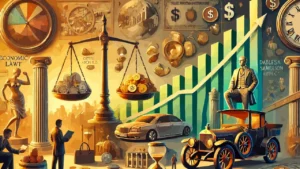Bubbles are cyclical events that have profoundly affected the global economy throughout history. A bubble occurs when the price of a good or financial asset increases disproportionately to its real value, fueled by euphoria, speculation, and unrealistic expectations. When investor confidence collapses, the bubble bursts, causing massive economic losses and often systemic crises.
This article explores the most significant bubbles in history, analyzing how they developed, the peaks in value reached, the losses suffered and the responses of the authorities.
Contents
- What is a bubble?
- The Tulip Bubble (1637)
- The South Sea Bubble (1720)
- The Mississippi Bubble (1720)
- The British Railroad Bubble (1840-1847)
- The American Railroad Bubble (1860-1873)
- The 1929 Stock Market Bubble (1929)
- The Japanese Bubble (1986-1991)
- The Dot-com Bubble (1995-2000)
- The American Housing Bubble (2007-2008)
- The Oil Bubble (2007-2008)
- The Bitcoin Bubble? (2009 – ?)
#1. What is a bubble?
A bubble forms when the price of an asset far exceeds its intrinsic value due to a wave of speculation. The initial euphoria attracts more and more investors, creating a cycle of artificial price growth. However, when economic reality no longer supports the inflated valuations, confidence quickly dissipates and the bubble bursts, causing devastating financial crashes. Bubbles can involve different markets: stocks, real estate, commodities or cryptocurrencies. The cycle of a bubble includes four main phases: innovation, euphoria, crisis and panic.
There is also another definition of bubble, more ironic and less relevant to the reality of the facts, which however made me laugh a lot when I heard it and so I decided to include it:
A bubble is a bull market in which you do not have a long position.
Financial bubbles are characterized by collective psychological dynamics, such as herding behavior and greed , which amplify the irrationality of investments. Authorities often intervene only after the bubble has burst, implementing stricter regulations to prevent future speculative excesses.
#2. The Tulip Bubble
1637
Known as the first speculative bubble in history, Tulip Mania burst in the Netherlands in the 17th century. Tulips, recently introduced to Europe via Turkey, became objects of great desire for their rarity and beauty. Some varieties, such as the “Semper Augustus” tulip, reached extraordinary prices, with bulbs selling for the price of a luxury home of the time. The speculative fever pushed investors of all social classes to participate in the market, transforming the bulbs into financial instruments. Prices soared, fueled by a parallel market based on futures contracts.
The dynamics of the bubble were fueled by the desire for quick profits: tulips were traded several times a day without the bulbs actually changing hands. This practice created a virtual economy focused only on speculation. However, in 1637, demand suddenly collapsed during an auction that went unsold, causing prices to plummet.
The losses were huge: many investors lost their homes and entire fortunes. It is estimated that tulip prices fell by 99%, with devastating consequences for the Dutch merchant class. The crash had repercussions on the Dutch social and economic fabric, although it did not cause a systemic collapse. The Dutch authorities attempted to mediate legal disputes between creditors and debtors, but avoided direct intervention in the market.
The tulip bubble remains a symbol of speculative excess and is often cited as a warning against irrational markets.
#3. The South Sea Bubble
1720
In England, the South Sea Company was given a monopoly on trade with the Spanish colonies, arousing the enthusiasm of British investors. The company issued shares that increased in value thanks to an exaggerated advertising campaign, which promised extraordinary profits. Many aristocrats and politicians invested enormous sums, fueling speculation.
The share price soared from £100 to over £1,000 in a matter of months, reaching unsustainable levels. When it became clear that the gains were largely illusory and that real profits were meager, confidence collapsed and the market crashed. The crash was sudden and devastating: thousands of investors lost their savings and many financial institutions failed.
The British government was forced to intervene. Parliamentary inquiries were launched to identify those responsible for the fraud and new laws were introduced to prevent excessive speculation. However, the economic damage was profound and affected confidence in British markets for years.
The crisis is estimated to have caused losses equivalent to billions of today’s pounds, impoverishing entire families and destabilising the banking system. It marked a turning point in financial regulation in the UK, with increased supervision of limited companies and tightening of laws against unfair speculative practices.
#4. The Mississippi Bubble
1720
In France, the Compagnie du Mississippi, founded by John Law (Giovanni Legge in Italian 😂), promised immense wealth through trade with the American colonies. Law, who also controlled the French central bank, began issuing large amounts of money to finance the purchase of company shares. This caused prices to rise exponentially.
Investors, attracted by the prospect of easy profits, rushed to the market. Shares reached irrational prices as speculative euphoria increased. The Company’s shares went from 500 to 10,000 livres in a few months. However, the bubble burst when investors began to doubt the sustainability of the gains. The market quickly collapsed, generating panic among investors.
The crash caused banks to fail and thousands of savers to be ruined. Confidence in the French banking system was seriously damaged and the crisis had repercussions on the national economy for years. The French government was forced to intervene, but the measures adopted were ineffective in restoring stability.
The crisis is estimated to have caused losses of over 1.5 billion livres, leading to the devaluation of the currency and a deep crisis of confidence in the French economic system. The Mississippi Company bubble remains one of the most emblematic examples of how excess liquidity and lack of regulation can lead to devastating financial crises.
#5. The British Railroad Bubble
1840-1847
During the Industrial Revolution, the construction of railways in the United Kingdom became a symbol of technological progress and economic expansion. Railways represented the future of transportation and a new investment opportunity. The British government, excited about the potential economic benefits, granted numerous licences for the construction of railway lines . Investors began buying railway stocks with the expectation of extraordinary profits.
Within a few years, the euphoria reached unsustainable levels. The number of railroad projects grew exponentially, many of which were economically unsustainable. Railroad company stocks reached sky-high prices: some tripled or quadrupled their initial value. However, this growth was based on unrealistic expectations rather than solid fundamentals.
The bubble peaked in 1845, when the railroad stock index hit record highs. However, the first signs of trouble emerged when construction costs exceeded expectations and some companies began to accumulate debt. Frightened investors began selling their stocks, triggering a downward spiral.
In 1847, the bubble burst. Prices fell rapidly and numerous railway companies went bankrupt. The losses were enormous: thousands of investors lost their savings and numerous banks involved in financing the projects went bankrupt. The British government, initially reluctant to intervene, was forced to introduce stricter regulations to prevent similar situations from recurring.
The British railway bubble is one of the clearest examples of how collective enthusiasm can distort financial markets and cause economic disaster. Despite the losses, many railway infrastructures built during this period survived and contributed to the long-term economic development of the United Kingdom.
#6. The American Railroad Bubble
1860-1873
In the United States, railroad construction became a symbol of the conquest of the West and industrial expansion. The federal government incentivized railroad construction through subsidies and land grants, prompting numerous companies to join the race to connect the Atlantic and Pacific coasts.
Investors flocked to the railroad industry, attracted by the prospect of high profits. Railroad companies issued bonds and stocks to finance projects, and banks supported expansion with generous loans. However, speculative enthusiasm soon exceeded the limits of economic rationality. Many projects proved unfeasible or poorly profitable.
The bubble peaked in the early 1870s, when railroad stocks reached valuations that were inflated relative to their actual profits. The breaking point came in 1873 with the bankruptcy of Jay Cooke & Company, a major bank involved in financing railroads. This event triggered the Panic of 1873, a financial crisis that spread rapidly, causing the stock market to crash and the failure of numerous banks and railroad companies.
The losses were enormous: tens of thousands of workers lost their jobs, and many towns that had developed around abandoned railroad projects fell into decline. The federal government responded late and with limited measures, worsening the crisis, which dragged on for several years, starting the so-called Great Depression of the 19th century.
This crisis marked a turning point for American financial regulation, pushing for greater supervision of markets and banks. However, the main lesson was the need to balance innovation and prudence in infrastructure investments.
#7. The 1929 Stock Market Bubble
1929
The 1929 bubble, which culminated in the Wall Street crash and ushered in the Great Depression, is one of the most catastrophic financial events in modern history. During the 1920s, known as the Roaring Twenties, the American economy experienced an unprecedented expansion. Stock markets grew rapidly, fueled by a wave of optimism, easy credit, and a growing speculative culture.
Investors, driven by the idea that the market could only go up, bought stocks on margin, borrowing money to invest. This mechanism amplified the market’s growth, causing the Dow Jones Industrial Average to rise from about 100 points in 1924 to a peak of more than 380 points in August 1929.
However, the euphoria hid serious economic imbalances: industrial overproduction, high debt, and a declining housing market. As investors began to lose confidence, selling increased rapidly. On October 24, 1929, known as Black Thursday, the market crashed sharply. The panic culminated on October 29, Black Tuesday, when millions of shares were sold off, causing the markets to crash.
The value of the stock market fell by nearly 90% in the following months. The losses were devastating: thousands of banks failed, millions of people lost their savings, and unemployment reached record levels. The crisis quickly spread globally.
The U.S. government, initially reluctant to intervene, subsequently launched the New Deal under President Franklin D. Roosevelt, introducing banking reforms and economic stimulus plans. New laws were passed to regulate financial markets, including the Glass-Steagall Act, which separated commercial and investment banks.
The 1929 Bubble remains one of the most emblematic examples of the dangers of unbridled speculation and the lack of adequate financial controls.
#8. The Japanese Bubble
1986-1991
The Japanese bubble of the 1980s is one of the most striking examples of excessive credit expansion and speculation in real estate and stock markets. Japan, which had been experiencing decades of sustained economic growth, saw asset prices explode as a result of loose monetary policies and a climate of economic euphoria. Japanese banks made easy loans, often backed by overvalued real estate, further fueling the speculative spiral.
Between 1985 and 1990, real estate values in major Japanese cities tripled, while the Tokyo Stock Exchange hit record highs. The Nikkei 225 index hit an all-time high of 38,957 in December 1989, with stock valuations completely disconnected from economic fundamentals. Japanese companies invested heavily in real estate and stocks, creating a self-sustaining bubble cycle.
The breaking point came in the early 1990s when the Bank of Japan (BOJ), concerned about inflation and instability in the financial system, decided to raise interest rates. This monetary tightening caused a sharp slowdown in credit and a consequent fall in asset prices. The collapse was rapid and devastating: between 1990 and 1992, the value of the Nikkei halved, falling to around 15,000 points, and the real estate market lost over 60% of its value.
The economic losses were immense. Japanese banks were overwhelmed by bad loans, and the liquidity crisis led to the failure of many financial institutions. The Japanese government intervened with stimulus packages and the creation of bad banks to manage the bad loans, but the effects of the crisis lasted more than a decade, marking the beginning of the so-called “Lost Decade.”
The Japanese bubble remains a key case study for understanding the risks of excessively expansionary monetary policies and the importance of banking supervision to prevent speculative bubbles.
#9. The Dot-com Bubble
1995-2000
The Dot-com Bubble was one of the most emblematic episodes in the recent history of technological speculation. In the 1990s, with the explosion of the Internet and new digital technologies, a climate of euphoria was created in the financial markets. Investors, attracted by the potential of the Internet, invested massively in technological startups, often without any analysis of economic fundamentals.
Internet-related companies were going public at astronomical valuations, even though many of them had no profits or sustainable business models. The NASDAQ Composite Index, the main benchmark for technology stocks, rose exponentially, from about 1,000 points in 1995 to over 5,000 points in March 2000.
The bubble peaked with multi-million dollar IPOs by emerging companies such as Pets.com, Webvan, and eToys, which quickly burned through their capital without ever reaching profitability. The speculative euphoria led to extreme overvaluation of technology stocks.
The bubble burst between 2000 and 2001 when investors began to doubt the solidity of many technology companies. The NASDAQ fell by more than 75% in a matter of months, falling below 1,500 points. Thousands of companies went bankrupt, and it is estimated that investors lost about $5 trillion.
The US government and the Federal Reserve responded by cutting interest rates and introducing expansionary monetary policies to limit the economic damage. However, the crisis had significant consequences for the real economy, with mass layoffs in the technology sector and a long period of stagnation for stock markets.
The Dot-com Bubble left behind important lessons about the need for careful valuation and caution in speculative investing, profoundly influencing the regulation of technology markets in the years that followed.
#10. The American Housing Bubble
2007-2008
The American Housing Bubble is considered one of the main causes of the global financial crisis of 2008. Fueled by low interest rates, lax credit policies and a growing subprime mortgage market, the bubble developed in the US housing sector during the early 2000s. Banks granted mortgages even to borrowers with poor repayment capacity, creating an artificial growth in demand for homes.
Real estate prices soared, reaching unprecedented highs in 2006. In some areas of the United States, home prices doubled in less than a decade. The financial sector further fueled the bubble through mortgage securitization: banks packaged mortgages into mortgage-backed securities and sold them to investors, often masking the actual risk.
When borrowers began to default on their loans, the bubble burst. Foreclosures increased dramatically, causing real estate prices to collapse. Banks that had invested heavily in subprime mortgage-related securities suffered huge losses. The collapse of the investment bank Lehman Brothers in September 2008 was the defining event of the financial collapse.
The stock market crashed and the global economy went into recession. Total losses were estimated to exceed $10 trillion worldwide. Millions of people lost their homes and jobs, and confidence in financial markets collapsed.
The US government stepped in with massive bailouts, such as the Troubled Asset Relief Program (TARP), which allocated $700 billion to stabilize the banking system. The Federal Reserve adopted expansionary monetary policies, lowering interest rates and implementing Quantitative Easing to stimulate the economy.
The crisis triggered by the housing bubble had global consequences and led to a review of financial regulations. In the United States, the Dodd-Frank Act was introduced to increase transparency and limit risky banking practices.
#11. The Oil Bubble
2007-2008
The Oil Bubble between 2007 and 2008 was characterized by a surge in crude oil prices fueled by speculation in the commodity markets, geopolitical imbalances and growing demand from emerging economies such as China and India. The price of a barrel of oil reached an all-time high of $147 in July 2008, driven by rising global demand and supply concerns.
Speculative investors played a crucial role in driving up prices, using futures contracts and derivatives. Investment funds and hedge funds poured capital into commodity markets, helping prices rise far beyond levels justified by supply and demand fundamentals.
However, the outbreak of the global financial crisis in 2008 had a devastating impact on the oil market. With the slowdown of the world economy, demand for oil fell rapidly. In a matter of months, the price of a barrel fell from $147 to less than $40, marking one of the fastest falls in the history of the oil market.
The consequences were severe for oil-producing countries, which faced budget deficits and economic recessions. Many oil companies also reduced investments and laid off thousands of employees.
Financial regulators, in response to the crisis, introduced new rules to limit speculation in commodity markets. However, the debate over the actual effect of speculation on oil prices remains open.
The 2008 Oil Bubble is considered a prime example of how financial markets can drastically influence commodity prices, with economic repercussions on a global scale.
#12. The Bitcoin Bubble?
2009 – ?
Bitcoin, the first decentralized cryptocurrency, was launched in 2009 by an entity known by the pseudonym Satoshi Nakamoto. Since its inception, Bitcoin has attracted great interest among investors, technologists and speculators, becoming the symbol of a new financial era based on blockchain technology.
The explosive growth in the value of Bitcoin has raised questions about its nature: is it a financial revolution or a speculative bubble destined to burst? From an initial value of a few cents, Bitcoin has reached extraordinary peaks: in December 2017 it touched 19,783 dollars and then collapsed to around 3,200 dollars in December 2018. After this phase of strong volatility, Bitcoin recorded new records around 2025, exceeding 100,000 dollars per unit.
Bitcoin’s extreme volatility has been fueled by growing adoption by institutional investors, the launch of cryptocurrency futures and ETFs, and growing interest from retail investors. However, the lack of regulation and the risk of fraud and market manipulation have raised concerns among financial authorities around the world.
The cryptocurrency market as a whole reached a market capitalization of over $3 trillion in 2021, attracting the attention of governments and central banks. However, subsequent events, such as the collapse of major cryptocurrency exchanges (including FTX in 2022) and regulatory restrictions introduced in several countries, have highlighted the fragility of the system.
Global financial authorities have taken different approaches: some countries have banned mining and the use of cryptocurrencies as a means of payment, while others have sought to regulate the market to reduce systemic risks. Despite this, Bitcoin continues to be considered by many as a “safe haven” or “digital gold”, while others see it as one of the largest speculative bubbles in history.
The debate about the future of Bitcoin remains open. Its decentralized nature, the lack of an underlying asset, the fact that it is stored in digital wallets without being used, and its growing popularity make it a unique phenomenon in the financial markets. However, its volatility and regulatory uncertainties fuel the risk that Bitcoin could still burst like a bubble, with unpredictable consequences on global markets.
History will tell us whether Bitcoin represents a lasting revolution or yet another episode of financial speculation destined to collapse under the weight of its own contradictions.





Leave a Reply